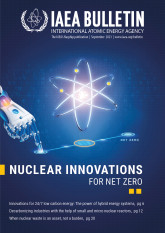
If you would like to learn more about the IAEA’s work, sign up for our weekly updates containing our most important news, multimedia and more.
Embracing the Promise of Additive Manufacturing for Advanced Nuclear Reactors
Lucy Ashton

3D-printed fuel assembly brackets, manufactured by Oak Ridge National Laboratory (ORNL) in partnership with Framatome and Tennessee Valley Authority. (Photo: F. List/ORNL, US Department of Energy)
Imagine printing a nuclear reactor core — or nuclear fuel pellets — in 3D. It may sound far-fetched that 3D printing could create materials robust enough to withstand the extreme environment of a nuclear reactor, yet that is what many experts believe is necessary to accelerate the deployment of advanced reactors and maximize nuclear energy’s contribution to tackling climate change.
In the future, the nuclear industry may make extensive use of 3D printing and other advanced manufacturing techniques, just as the aeronautical and automotive industries are already doing.
Already used in some industries, 3D printing is a form of additive manufacturing and involves a process that prints objects by building up material, layer by layer. This is in contrast to subtractive manufacturing, which cuts or burns away surplus material. 3D printing works directly from a digital drawing and is controlled by a computer, producing intricate shapes that were previously difficult or impossible to make. This method of manufacturing is faster, creates less waste, reduces the potential for error and often allows designers to reduce the weight of objects — all attributes that could significantly reduce manufacturing costs.
“In the future, the nuclear industry may make extensive use of 3D printing and other advanced manufacturing techniques, just as the aeronautical and automotive industries are already doing,” said Aninda Dutta Ray, a nuclear engineer working on advanced manufacturing at the IAEA. “The potential is certainly there. The first steps are well underway with intense research and reviews against existing nuclear design codes and standards being undertaken, while some regulators have even started drafting guidance for their licensees.”
Introducing and testing 3D prints
As with most new manufacturing processes, the first steps are small, slow and cautious. The nuclear industry has seen some first-use cases, such as a 3D-printed pump impeller installed at a Slovenian reactor in 2017. The fan or turbine-like component drives water through the pump. It was 3D printed because the original drawings for the component were not available.
In the United States of America, Oak Ridge National Laboratory (ORNL) is developing 3D printing technologies for the nuclear field and other industries. In a first-of-a-kind test, ORNL printed brackets called channel fasteners. The pieces were installed in a nuclear power reactor in 2021 and will remain there until 2027, before being extracted and inspected to evaluate their performance under the reactor conditions. The French multinational company Framatome installed the first 3D-printed, stainless steel fuel component at the Forsmark nuclear power plant in Sweden in 2022. In addition, the Russian Federation recently built a 3D printer capable of printing objects with a diameter of up to 2.2 metres and a height of 1 metre, while in the Republic of Korea, 3D printing is being used to manufacture items such as control valve components.
As 3D printing was not invented with the nuclear industry in mind, the manufacturing techniques are being adapted to the industry’s needs. While industrial standards organizations are creating standards for 3D printing in other industries, those for nuclear are still under development.
According to Dutta Ray, figuring out the best testing methods, standardizing them around the world and gaining approval from regulators is arguably more challenging than the actual innovation and perfection of the manufacturing techniques themselves. In Europe, the NUCOBAM (NUclear COmponents Based on Additive Manufacturing) project, which brings together a group of 13 organizations in 6 European countries, is conducting research to develop the qualification and evaluation process that would allow 3D printing to be used in nuclear power plants.
The Electric Power Research Institute (EPRI) is also working alongside the US Department of Energy and manufacturers to carry out research in order to streamline the regulatory acceptance of new technologies, such as 3D printing. That research is focused on investigating the applicability of advanced manufacturing technologies, developing codes and standards, and supporting regulatory reviews with independent test results for material performance against environmental degradation. “The demand for alternative supply chains and accelerated deployment is increasing markedly as the energy industry continues to transition to advanced energy systems such as advanced reactors,” said Marc Albert, EPRI’s Principal Team Lead for advanced manufacturing projects. “Additive manufacturing and other advanced manufacturing methods are enablers to accelerate the deployment of the clean technologies.”
Role of the IAEA
One of the roles of the IAEA is to foster international cooperation and knowledge sharing. In April 2023, the IAEA launched the International Network on Innovation to Support Operating Nuclear Power Plants (ISOP). ISOP is an inclusive network and serves as a platform for countries to collaborate on a range of innovation topics, including advanced manufacturing techniques such as 3D printing.
In June 2022, the IAEA also launched its Nuclear Harmonization and Standardization Initiative (NHSI), which focuses on facilitating the deployment of safe and secure advanced nuclear reactors and small modular reactors. The NHSI aims to harmonize regulatory approaches and to develop more standardized industrial approaches, including common approaches to nuclear codes and standards applicable to additive manufacturing for SMRs.
“Collaborative innovation is the key to getting the next generation of nuclear technology safely out of the lab and into the world as soon as we can to help with net zero goals,” said Ed Bradley, Team Leader for Nuclear Power Plant Operation and Engineering Support at the IAEA. “Sharing findings, techniques and knowledge saves time and resources by eliminating the need for every nuclear nation to complete the same test or spend money to overcome the same sticking points. That is how we are going to succeed.”






